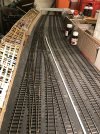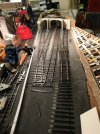Just for my own curiosity since exactoscale do P4 checkrail chairs at 0.68mm and you guys are saying that 1mm is the EM standard where has the 0.8 clearance come from that exactoscale are using?
Hi Jim
From the EMGS track standards, the crossing flangeway has 1mm clearance, and by ( hopefully correct) subtraction, the check rail clearance is 0.95mm. I suspect many EM modellers are content to work to 1mm for both.
The EMGS nominal standard for a point checkrail, on 18.2mm track is 17.25mm from inner edge of running rail to furthest edge ( nearest opp running rail) of the checkrail.
And the 0.8mm clearance? In theory it should work, either for EM points or for "gap widened" P4 checkrails on sharp curves. I think Exactoscale used to market them as suitable for EM.
However, some people prefer the simplicity of Romford-style EM axles, and when used with at least one Romford-style wheel, had a back to back measurement less than EMGS standard. Not being in the habit of buying these wheels, I can't comment on current or recent production.
hi Overseer
By default, I replace all rtr freight and coach stock wheels with Gibson for consistency, having learnt the hard way that regauging Lima wheels didn't stop the pizza cutter flanges bounce over sleepers! Locomotives are still on the to do list.
Kier Hardy has a good solution to Rtr loco flanges in his website
EM Gauge Layouts, Models & Projects. But you do need the use of a lathe, and possibly a little courage until familiar with the process.
Dave Franks on his Wharfside layout uses a very consistent choice in wheels, but increases the back to back very slightly and gets superb running as can be seen in his party piece videos of high speed propelling through pointwork. I'm pretty sure he doesn't change track standards, just reduces the amount of lateral move the wheel set has.


